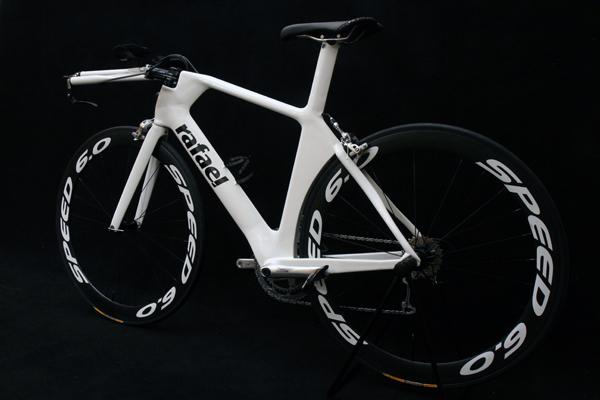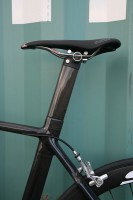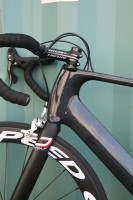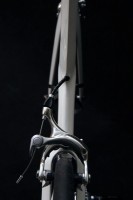- News
- Reviews
- Bikes
- Components
- Bar tape & grips
- Bottom brackets
- Brake & gear cables
- Brake & STI levers
- Brake pads & spares
- Brakes
- Cassettes & freewheels
- Chains
- Chainsets & chainrings
- Derailleurs - front
- Derailleurs - rear
- Forks
- Gear levers & shifters
- Groupsets
- Handlebars & extensions
- Headsets
- Hubs
- Inner tubes
- Pedals
- Quick releases & skewers
- Saddles
- Seatposts
- Stems
- Wheels
- Tyres
- Tubeless valves
- Accessories
- Accessories - misc
- Computer mounts
- Bags
- Bar ends
- Bike bags & cases
- Bottle cages
- Bottles
- Cameras
- Car racks
- Child seats
- Computers
- Glasses
- GPS units
- Helmets
- Lights - front
- Lights - rear
- Lights - sets
- Locks
- Mirrors
- Mudguards
- Racks
- Pumps & CO2 inflators
- Puncture kits
- Reflectives
- Smart watches
- Stands and racks
- Trailers
- Clothing
- Health, fitness and nutrition
- Tools and workshop
- Miscellaneous
- Buyers Guides
- Features
- Forum
- Recommends
- Podcast
feature
 rafael r-009_10_600
rafael r-009_10_600rafael: carbon done differently – is this the future of the carbon bike?
rafael was a late entry to the exhibitors list at the first European Handmade Bicycle Exhibition was a brand name very few attendees would have known or heard of rafael. That is changing fast, not only due to the eye-catching designs appearing under its name but because rafael claims to have found a method of production that will revolutionise the building of carbon frames.
German designer Rafael Hoffleit, a 32-year-old triathlete from the town of Heidelberg is the man behind rafael. By day, Hoffleit is an architect .
However there is another string to his bow, as Rafael is also highly accomplished in carbon fibre technology and techniques, producing parts for the Audi and Mercedes motor-sport teams and for a leading Formula 1 team.

Fortunately (for the bike world), Hoffleit's enduring passion is bicycles.
As a 9-year-old, he was modifying his own bike by adding fairings. He welded his first bike, a recumbent, shortly afterwards. Aged 16 he produced his first carbon-fibre model, this one a fully faired recumbent with carbon fibre fairings. Quite an acheivement for a teenager - but he didn't stop there!
As Hoffleit told us, "after a short interruption - because I was getting my drivers license - I started building bikes again. This time I was influenced more by my sport, triathlon. Among others, a sub 800g carbon roadbike-frame, and a full carbon folding bike were created".
More concept bikes followed along with a steady, albeit small, stream of race bikes built during precious hours away from his architects drawing board or training for and competing in that most gruelling of single-day events, the Ironman-distance triathlon.

At EHBE, rafael – the brand – (note the small 'r') took the bold step of finally unveiling his striking concepts and creations to public and press alike. road.cc featured some of them in its EHBE coverage.
First to catch the eye, the Heidelberg, is a Stealth bomber-like Gates Drive-powered single-speed – which we really liked the look of; its bare, jet-black carbon frame made all the more striking by being paired with day-glo acid-green wheels and bar grips.


This features a stunning full-carbon fuselage built in one piece using only parts developed and produced in-house by Hoffleit; no sub-assemblies, such as stays, dropouts or tubing are used in the frames' creation. The handlebars are also an in-house production, built with the same one-piece construction as the frame.

The r-008, nicknamed the "slimandfast" didn't feature in our EHBE coverage. This is a long-distance tri/road model, with one-piece frame; same full in-house production, and unique features such as the hollow carbon fibre dropouts, dual-chamber top and down tubes and internal, fully concealed Shimano electronic Di-2-compatible cable routing. On top of all that is a slippery, integrated – but fully removable – seat post, which also acts as storage area for the on-board hydration system.



Alongside the Heidelberg and slimandfast, was an equally-striking, truly cutting edge model; the r-009.

The concept behind the r-009 was to build a TT/triathlon bike for a rider only 160cm (5' 3”) but capable of running full-size 700c wheels. The low seat tube, combined with the short top tube and need to run aero bars presented a challenge Hoffleit relished in. As well as designing and building the frame from scratch, he also developed an aerobar cockpit, a unique all-carbon steering system, still capable of using off-the-shelf stems or bars if required.

The aerobar, the r-001, is also available as a stand-alone product.



There's a saying amongst designers that 'if it looks good, it usually works good'.
This could not be truer of the rafael 009. It doesn't just look good – it looks perfect; a perfect example of a state-of-the-art machine, a bike designed with one rider in mind, a bike built for racing against the clock at the highest level.
What's all the more remarkable about these bikes is the fact that all are produced using a system devised entirely by Hoffleit.
To understand the signifcance of his new building methods we need to take a quick look at the time-line for carbon bike construction: the first bikes were either carbon tubes held in lugs, built in much the same way as traditional steel, lugged frames – with epoxy and ovens replacing welding torches and brazing rods.
Then came monocoque construction, built in one or two pieces and using carbon sheet laid into pressurised or vacuum moulds. This is a costly affair, with each design and frame size requiring a separate mould as well as being labour-intensive and requiring skilled technicians.

Radius Engineering, developers of the Kestrel, a moderately successful '80's carbon monocoque, came up with a patented system to produce frames using pre-formed thermoplastic/carbon couplings to which stock carbon tubing was bonded. The result was a lower-cost, lightweight frame with the look of a monocoque.
This design was to be licensed by Trek in the early '90's and dubbed the OCLV. Sales were underwhelming – until an OCLV carried Lance Armstrong to his first TDF win in 1999.
For custom designs, 'tube to tube' construction became the route chosen by a number of custom carbon builders. This is where pre-formed tubes are mitred, bonded, then wrapped with more layers of carbon and epoxy. While this produces a high-strength, low-weight frame, the monocoque is still considered the superior method. But the high cost of producing individual moulds for each riders' design means custom monocoque frames have been prohibitively expensive.
Until now, that is.
The manufacturing process developed by rafael is not a new idea – in fact its doubtful if there is a carbon frame builder out there who hasn't at one point considered the possibilities of custom monocoque production.

However, up until now, no-one has been able to turn the concept into reality – until now. Custom monocoque construction – the Holy Grail of framebuilding - is very much a reality and taking place in rafael' workshops.
Its a process with endless possibilities; not one restricted to race machines alone.
Says Hoffleit,
"For the bespoke road bike I developed a special system with adaptable moulds. It is completely new and gives me the possibility to build custom-made frames with
an aerodynamic design instead of the standard round tubes found in the normal carbon bespoke market.
“Another feature of this system is that I have the possibility to make small modifications in every part of the frame. Very important for me and my athletes."
He's keen to point out the opportunities his system offers:
"The bicycle is such a great idea (perhaps one of the greatest). You can do so many things with it, it would be such a waste only using it for sports. That's why the "rafael concepts" part of my work is so important for me. There will be special things like folding bikes or maybe recumbent bikes coming soon."
10 years is a long time in the world of bike design.
Who's to say in a decade from now, the riders lining up for the start of the 2019 TDF will not be riding bicycles featuring some of the concepts and designs created by this brilliant young triathlete turned inventor from Heidelberg?
That will be thirty years on from a rider capturing the Tour De France using 'revolutionary' triathlon bars; twenty years after a former triathlete turned cycling on its head and scored his first TDF win on a carbon bike, and a decade on from Armstrong's epic return to cycle racing, aiming for a fin de siècle shot at Tour glory.
There's quite a few coincidences in there (for those who put stock in those kind of things) to latch on to.
rafael's home town of Heidelberg is best known as the place where Karl Drais invented his two-wheeled 'running machine' or 'Draisienne' – the first bike - in 1819 ... yet another coincidence.
Thanks to Neil from Frameforum.org for contributing this feature
My understanding was traffic data also suggests that its actually made driving quicker not slower in Paris....
"...pedestrians remain unable to access the site due to safety reasons." Who is causing the danger?
You missed the most important part of the Cycling UK rebrand, which was them taking a side in the cycling cat debate.
"... struck by a driver..." http://rc-rg.com
That's only for longer journeys; obviously for short trips he employs the sedan chair.
In accordance with the highway code ? bus driver was breaking the speed limit, overtaking a child on a bicycle, he should've as far right as...
One is permantly in misery mode, the other all blacked out in stealth mode.
...and go and ride your bike for two hours or less.
Just put in planning permission for a NASA sized warehouse the area of ten football pitches, right up against local housing. That'll go through no...
It reminds me of the joke that used to do the rounds when I was younger;...